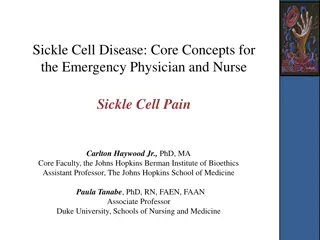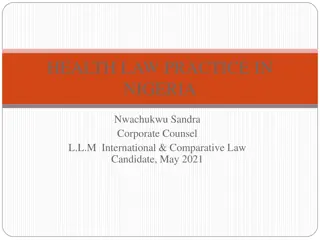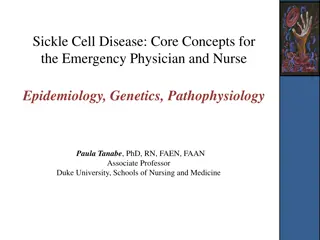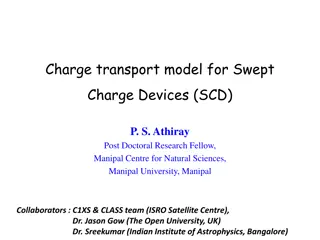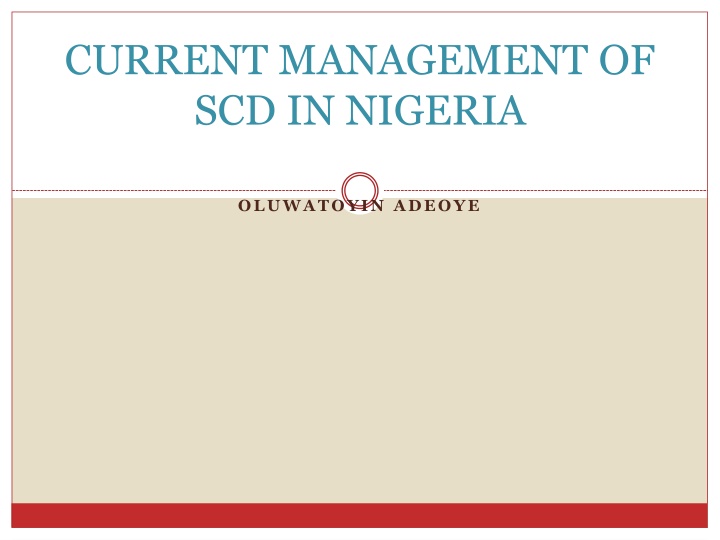
Sickle Cell Disease Management in Nigeria by Oluwatoyin Adeoye
Explore current management practices for sickle cell disease in Nigeria as outlined by Oluwatoyin Adeoye. Learn about the genetics, clinical presentations, and challenges faced in the management of this inherited blood disorder affecting millions of Nigerians.
Download Presentation

Please find below an Image/Link to download the presentation.
The content on the website is provided AS IS for your information and personal use only. It may not be sold, licensed, or shared on other websites without obtaining consent from the author. If you encounter any issues during the download, it is possible that the publisher has removed the file from their server.
You are allowed to download the files provided on this website for personal or commercial use, subject to the condition that they are used lawfully. All files are the property of their respective owners.
The content on the website is provided AS IS for your information and personal use only. It may not be sold, licensed, or shared on other websites without obtaining consent from the author.
E N D
Presentation Transcript
CURRENT MANAGEMENT OF SCD IN NIGERIA OLUWATOYIN ADEOYE
1 JOHN 4: 8 BUT ANY ONE WHO DOES NOT LOVE DOES NOT KNOW GOD, FOR GOD IS LOVE.
OUTLINE INTRODUCTION CLINICAL PRESENTATIONS MANAGEMENT PATIENT/ PARENTS DOCTORS/ HEALTH TEAM
INTRODUCTION What is sickle cell disease? Sickle cell disease [SCD] is a genetically inherited disease in which an amino acid glutamic acid in position 6 on the beta globin is replaced by another amino acid called valine; leading to production of defective haemoglobin S.
An individual with SCD has inherited 2 abnormal haemoglobin genes, one of which is HbS. The most common and most severe is SS disease. Others are SC, S - thal,
In SCD, the red blood cells assume an abnormal rigid sickle shape. It occurs in 1 million Nigerians. Over 40 million Nigerians are healthy carriers of the S gene. About 150,000 children are born each year with HbSS.
It is an autosomal recessive disorder. The one in four chance of SS occurs with each pregnancy. The severity of SCD is multifactorial type, haplotype, level of care etc
CLINICAL PRESENTATIONS These are usually due to decreased solubility of Hb S. The solubility of deoxy-Hb S is 1% of oxy- Hb S and 10% of deoxy Hb A. This decrease in solubility leads to rigidity of rbc membrane, sickle shape, and reduced life span.
Anaemia Jaundce Hepatosplenomegaly Hand and foot syndrome Small for age
CRISES Vaso- occlusive Hyperhaemolytic Sequestration Aplastic
Stroke Retinopathy Blindness Acute chest syndrome Chest infection Cardiomegaly Splenomegaly
Hepatomegaly Cholilithiasis Hypostenuria Haematuria Priampism Delayed puberty Avascular necrosis of femoral head Ulcer
Infections pneumonia Osteomyelitis UTI Sepsis Malaria
MANAGEMENT A. Patient/ Parents Regular follow up Balanced diet Water Healthy habits Take medications regularly Immunisation
B. Health team Diagnosis: Antenatal,neonatal, Investigations: Steady state pcv, Transcranial doppler (TCD), irreversible sickling, Fe studies. Others. Prevention of infection: immunization, proguanil, oral penicillin. Folate supplementation
Anti sickling agents: Nicosan, Ciklavit, Fagara zanthoxyloides, Hydroxyurea Follow up and counselling Management of acute illnesses and complications. Chronic transfusion therapy
Bone marrow transplantation: CVA Sub arachnoid haemorrhage Recurrent acute chest syndrome, Recurrent severe debilitating pain. Ova and sperm still SS.
1 CORINTHIANS 13:13 THERE ARE THREE THINGS THAT REMAIN FAITH, HOPE, AND LOVE AND THE GREATEST IS LOVE.
REFERENCES The Living Bible. 1. 2. Adekile AD, Adeodu AA. Haemoglobinopathies. In: Azubuike JC, Nkanginieme KEO, editors. Paediatrics and child health in a tropical region. 2nd ed. Owerri, Nigeria: African Educational Services 2007. p 373 386. 3. Olu Akinyanju OON, The National burden of sickle cell disorder and the way forward. Sickle cell Foundation Nigeria. P 3- 13
4. Sickle cell disease from wikipedia, http://en.wikipedia.org/wiki/SCD. 5. Aliyu ZY, Tumblin AR, Kato GJ. Current management of sickle cell disease. Haematologica. 2006; 91(1): 7-10. 6. Oniyangi O. Sickle cell disease: Information for the general public. The sickle cell clinic. National Hospital, Abuja.2007.
7. Muanya C. Scientists validate more cures for sickle cell anaemia. Natural health, Guardian. 2013.






